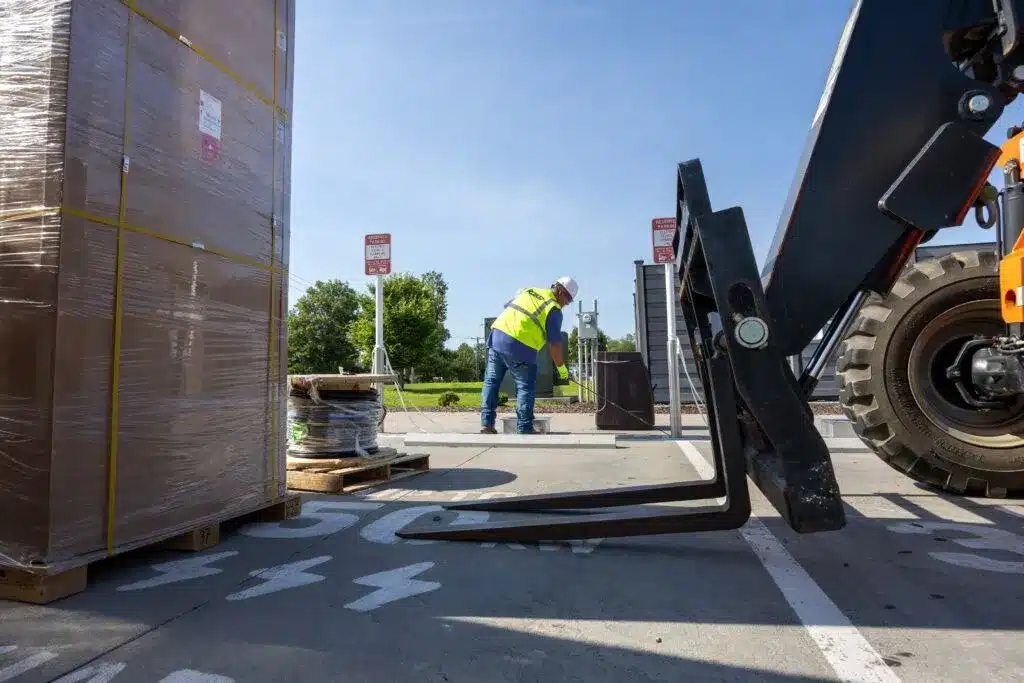Nebraska’s EV Charging Options Can Get You Places, but Needs Expansion for Future Needs
Don Cox, one of the first Nebraskans to own an electric vehicle, has put more than 400,000 miles on his EVs since 2008. In that time, he’s never once gotten stranded – though in the early days, he did have to plug into outlets at RV parks to get his Tesla Roadster across the state.
Today, there are 265 charging stations, and more than 500 individual ports, scattered across Nebraska, most clustered along the Interstate 80 corridor. There are also many more drivers like Cox – the number of EVs in Nebraska has grown sixfold just in the past six years.
Despite this growth, Nebraskans continue to lag behind other states in EV ownership. Only one out of every 362 registered vehicles in Nebraska is electric, a lower adoption rate than all but eight states.
A major deterrent: Widespread worry that there aren’t enough EV charging stations.
Nine out of 10 respondents to a 2022 Nebraska Department of Transportation survey said Nebraska’s charging infrastructure was insufficient for practical EV ownership.
But the reality, say the dozen EV drivers interviewed by the Flatwater Free Press, is that the charging infrastructure is getting better and more reliable, though it will take more charging options to unlock new owners.
“It’s come a long way,” Cox said while charging his car at a Lincoln Runza.
It only takes a brief glance at a map of public charging stations in Nebraska to understand where they are, and aren’t. Many are concentrated in the eastern half of the state, near the population centers. They then spread west, roughly following the path of I-80, which Nebraskans and out-of-staters alike use to traverse the state.
And, in some way, that charging map mirrors where EV owners are and aren’t in Nebraska.
There are now 7,000 registered EVs in Nebraska, but 23 Nebraska counties, many located in north-central and northwest Nebraska, don’t have a single EV registered in them. Cherry County, larger than the state of Connecticut and home to 5,455 residents, has zero registered EVs, according to data provided by the Nebraska Department of Motor Vehicles.
Among the likely reasons for this low ownership: So-called charging deserts, along with the fear that buying an EV may mean getting stranded.
The increasing number of chargers in Nebraska vary in charging time, upkeep and price, and often may require extra planning for road trips and rural driving, said EV drivers.
While most current EV owners typically charge at home overnight, a more robust public charging network could spur more EV adoption, said infrastructure experts.
Range anxiety – the fear of not making it to the next charger before the battery dies – is widely cited as a major barrier to American EV ownership. This anxiety can be lessened in two ways: Increasing battery size, which also drives up vehicle cost, or adding charging locations, said Steve Pekarek, a Purdue University professor specializing in power systems for EVs.
Nebraska’s power grid has the capacity to support more charging infrastructure in the foreseeable future, both at home and on the road, according to the Nebraska Public Power District and Omaha Public Power District.
OPPD hasn’t observed any overloads from areas with denser charging areas in the past five years, said Mark Gibilisco, manager of distribution planning, even as more contractors install home chargers in new Omaha-area homes.
And as battery costs drop significantly, EVs are expected to keep growing. A federal grant is meant to help states like Nebraska add charging stations, but Nebraska has also been slow to utilize this funding.
Home charging remains the most convenient way to top up an EV. A few owners told the Flatwater Free Press that at least 80% of their charging is done at home.
It’s also cheap. In the Omaha area, it costs no more than 10.5 cents per kilowatt-hour to charge at home, meaning you could charge to travel 300 miles for roughly $10.
But the growing home charging network still needs to be complemented by public charging, according to a report by the National Renewable Energy Laboratory.
Nebraska’s 577 charging ports are low for a state its size, said Jaap Burger, senior adviser for a Brussels-based energy research think tank. That’s especially true since less than 200 of those ports are fast chargers, which can fill up a battery in less than an hour.
“It’s not a charging network that enables people to use EVs for all of their driving needs in their state (or) across states for longer distances,” he said.
Burger once served as a project manager for the city of Amsterdam’s EV charging network, which now includes more than 2,000 ports for its residents.
Only eight public charging ports exist in Sarpy County, which indicates it’s a home-charging community, Burger said.
“It also means that probably certain residents won’t be able to switch to an electric vehicle today,” he said. Without a charging infrastructure that reflects current car ownership and also travel patterns “you basically lock people out of that option.”
Many current Nebraska EV owners say the chargers that do exist now need to be well-maintained and functioning. That’s especially important for EV owners like Danny Martin, who doesn’t own a charger at his rental home.
“I’ve seen broken chargers from pretty much every brand,” said Martin.
Martin parks his Hyundai Ioniq at a lower-level charger at work near the Bob Kerrey pedestrian bridge.
Four hours of level-two charging gives him about 80 miles of juice for the price of $1.
“We need more level-two chargers,” said Chad Pinkelman, an engineer with NPPD. As an EV owner himself, he said parked charging options make the most sense to him.
Level-two chargers near workplaces, grocery stores, gas stations and hotels typically work for those who have something to do while charging.

But for road trips, EV owners and experts alike say Nebraska needs more fast chargers.
Tim Kimpson, who bought a Tesla this year, is ready to take his Model Y on a road trip to Idaho in September. He and his wife Cindy will hit up the Black Hills along the way, planning to use Tesla Superchargers and calling hotels ahead to make sure their low-level chargers work.
“I wasn’t an EV believer,” Kimpson said, but changed his mind after a recent gas price hike. He also owns a pick-up that costs $85 to fill and gives him 250 miles before he has to fill up again.
“I can’t afford to put gas in my truck,” he said.
Dario Schicke, a restaurant owner in Omaha, almost exclusively travels in his EV. To him, the biggest draw isn’t saving money — charging at a fast-charging public station can cost almost as much as gas — but rather his EV’s design and driving ease.
He calls his EVs “little computers on wheels” and doesn’t mind the added charging time compared to a gas car.
His high-end Lucid Air can make roughly 500 miles on a full charge. His trick for charging: only charge to roughly 60% in no more than 20 minutes before heading to the next location, as most batteries’ charging speed tapers after a certain point.
“I don’t want my car to charge too much. It’s bad for the battery, you’re taking space for someone else and also it’s unnecessary,” he said.
Driving an electric vehicle on a road trip does add to the total travel time, said Schicke and other drivers. That’s why amenities around charging stations can appeal to EV drivers, said Nancy Meyer, who drives a Chevrolet Bolt for trips near her Cedar Bluffs home and travels in her husband’s Tesla.
“It also brings people into the town who might stop and buy something,” she said.
There are drawbacks, Alan Meyer points out. After being caught in a Texas snowstorm, his Tesla’s battery charge dropped significantly in the cold weather, and the car’s smart control system told him not to go over 60 mph on the couple’s return trip to Lincoln.
Meyer has used Tesla’s website, which allows owners to suggest new charging locations, to urge the company to add more chargers on U.S. Highway 20 and U.S. Highway 275, which both cut through northern Nebraska.
The charging landscape is worse for EV truck owners. Doug Allpress’ Ford F-150 Lightning includes a battery powerful enough that he used it to power his house’s essentials, including his refrigerator and freezer, after a recent storm knocked out electricity at his home.
But that big battery also requires a fast charger, and the only viable chargers Allpress has found, aside from those off I-80, are in Norfolk, Ainsworth, O’Neill, Thedford and Chadron.
“The biggest issue would be getting to Chadron,” he told the Flatwater Free Press, noting the city is 150 miles away from another public charging port, which could become dicey if a charger broke down.
For large delivery fleets, switching to electrics is not yet practical, according to Werner Enterprises, an international trucking company headquartered in Omaha. The company bought EV trucks last April, but its CEO announced later last year that they’ve found it difficult to commit to electrics due to high costs and power demands.
Charging electric trucks consumes a great amount of power. An average home operates at two kilowatts. An 80,000-pound truck needs 200 kilowatts, said Pekarek, the Purdue professor.
“So you’re talking in … multiple orders of magnitude higher just for one vehicle.,” he said.
There are no public semi-trailer truck charging stations in Nebraska, though some companies are using lighter electric trucks for shorter-distance delivery.
NPPD has added some EVs to their company fleet for cost-saving purposes, but they are mostly driven within city limits of Columbus.
OPPD recently helped Amazon build on-site charging stations for its Rivian delivery trucks at its new delivery center in Papillion. OPPD said Amazon had planned for electrification and notified the power districts of its needs ahead of time, streamlining the process.
Experts and EV owners alike think that if Nebraska continues to build its EV infrastructure, more electric vehicles of all kinds will grace its roadways.
“As you increase the number of stations, and you break down deserts, then there will be an increase in adoption,” said Pekarek.
Reprinted with permission from the Flatwater Free Press.
Written by Yanqi Xu and Naomi Delkamiller.
The Flatwater Free Press is Nebraska’s first independent, nonprofit newsroom focused on investigations and feature stories that matter.
